This website is supported by its readers. If you click one of my links I may earn a commission. I am also a participant in the Amazon affiliates program and I will also earn a commission from qualified purchases.
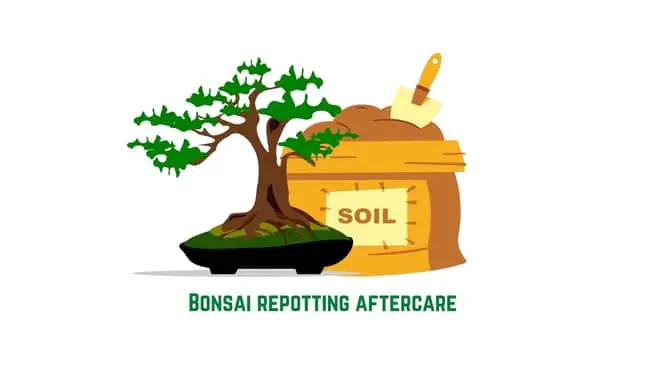
So recently, I had to repot my Chinese elm bonsai, as it had outgrown the pot it was in. One of the things I forgot about was just how much aftercare was required when repotting bonsai. So how do you ensure that your bonsai repotting aftercare is successful?
Watering your bonsai thoroughly after repotting, keeping your bonsai in the shade in warm climates, protecting your bonsai from insect infestations and fungal infections, and protecting your bonsai from the wind are all essential in the aftercare of repotting your bonsai.
So what are the main tips that you should follow to ensure you have a successful bonsai repotting? And what bonsai repotting aftercare techniques can you not afford to avoid? Keep reading to find out more!
Just a quick heads up, over the past three years of running Plantpaladin, hundreds of people have asked for product recommendations. As such, You can find my favorite indoor bonsai tree here (link takes you to Bonsaiboy), my favorite outdoor bonsai tree (link takes you to Bonsaiboy), or have a look at all the products I recommend here.
Bonsai repotting aftercare
One of the most common but also most dangerous times in the life of your bonsai is replanting, repotting, or transporting your bonsai from one pot to another.
Whilst most bonsai will survive the process there have been occasions whereby bonsai die during the process.
The main reason for this is because of bad bonsai repotting aftercare.
Luckily for you, I’ve spoken to a few experts, replanted a fair few bonsai trees myself, visited a few bonsai specialists, and even surveyed 20 plant paladin fans to ask them about their bonsai repotting aftercare techniques.
I found then that the following tips work best:
- Repot your bonsai at the right time of year
- Ensure your bonsai does not move around
- Water your bonsai as soon as it has been repotted
- Prevent your leaves from losing water
- Use a propagator
- Don’t interfere with your tree too much
- Consider your soil mix
- Have the right size bonsai pot for your tree
- Keep your bonsai in the shade in warm climates
- Fertilize your bonsai soil
- Invest in root hormone
- Keep a consistent temperature
- Invest in a greenhouse
- Protect your bonsai from bugs
- Avoid birds
- Invest in fungicide
- Protect your bonsai from the wind
Now it’s worth noting that whilst these techniques have been laid out for moving one regular bonsai tree from one pot to another, these tips can work when growing bonsai seedlings, cuttings, or even larger cuttings.

Repot your bonsai at the right time of year
The best bonsai repotting aftercare is done during or before the repotting process.
Sadly, if you were to repot your bonsai in the winter, the chances of success are going to dwindle.
Bonsai grow and propagate best during the early spring.
This is why any repotting undertaken must be done either in the early spring or at the very latest summer.
This will give your bonsai enough time to get used to the warmer temperatures, sprout its roots in the new soil mix but also have some growth afterward.
Now if you have repotted your bonsai too late into the year, then just heed this aftercare advice for the next time you need to repot your bonsai.
Ensure your bonsai does not move around
Easily one of the biggest things I’ve struggled with when managing bonsai repotting aftercare has just been getting my bonsai to stay still.
You see as your bonsai tree gets;’s used to the new soil mix and pot, it needs to stay perfectly still, or else the roots of the tree won’t propagate in the new soil.
As such, it is essential to use wires attached to your bonsai pots to help keep your bonsai in place and not moving for at least 4 to 6 weeks.
How many wires will depend on the size of your bonsai – After all bonsai comes in several different size classes.
Luckily however I’ve put together a table below to explain how many wires your bonsai tree will need to stay in place in your new pot:
Number of wires needed to secure bonsai
| Classification | Size inches | Size Centimeters | Hand size | General size | Number of wires needed to secure bonsai | Length of wire |
| Keshitsubo | 1 to 3 inches | 3 to 8 centimeters | Fingertip | Tiny | 1 | 10cm |
| Shito | 2 to 4 inches | 5 to 10 centimeters | One-hand | Tiny | 1 | 10cm |
| Mame | 2 to 6 inches | 5 to 15 centimeters | One-hand | Small | 2 | 15cm |
| Chohin | 5 to 8 inches | 13 to 20 centimeters | One-hand | Small | 2 | 15cm |
| Kumono | 6 to 10 inches | 15 to 25 centimeters | One-hand | Small | 2 | 15cm |
| Katade-mochi | 10 to 18 inches | 25 to 46 centimeters | Two-hand | Medium | 2 – 4 | 20cm |
| Chiu or Chumono | 16 to 36 inches | 41 to 91 centimeters | Two-hand | Medium | 4 | 25cm |
| Dai or Omono | 30 to 48 inches | 76 to 122 centimeters | Four-hand | Large | 4 | 20cm |
| Hachi-uye | 40 to 60 inches | 102 to 152 centimeters | Six-hand | Large | 6 | 40cm |
| Imperial | 60 to 80 inches | 152 to 203 centimeters | Eight-hand | Large | 8 | 60cm |
Securing fast-growing bonsai tree species
Now should your bonsai tree grow relatively quickly in the new pot, or propagate before the 4 to 6 weeks are over, I would still recommend keeping your bonsai fastened.
This is more likely to happen in faster-growing bonsai tree species.
Again I’ve created a table below showing the most common bonsai tree species on the commercial sale and how fast they grow to give you an indication if you will run into this problem:
| Bonsai species | Growth type | Average growth per year |
| Chinese Elm | Fast | 12 to 36 inches |
| Juniper | Moderate | 5 to 12 inches |
| Jade | Slow | 2 to 5 inches |
| Maple | Fast | 12 to 36 inches |
| Fukien Tea | Slow | 2 to 5 inches |
| Ficus | Fast | 12 to 36 inches |
| Wisteria | Slow | 2 to 5 inches |
| Cotoneaster | Moderate | 5 to 12 inches |
| Pine (most varieties) | Fast | 12 to 36 inches |
| Azalea | Slow | 2 to 5 inches |
How to prevent your bonsai from moving around
To prevent your bonsai from moving around simply loop the recommended number of wires around the trunk of your bonsai a few inches above the topsoil.
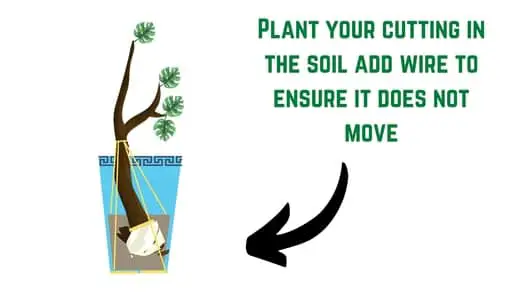
Then loop them with a metal or plastic pole in your topsoil or even better underneath or through the drainage holes in the bottom of your bonsai
Ideally, this will be done during the repotting process, however, the pole method can be undertaken afterward if you missed this the first time.
Water your bonsai as soon as it has been repotted
So as soon as you have repotted your bonsai, the most important bonsai repotting aftercare tip you should follow is to water your bonsai tree thoroughly.
The new roots will not be used to the soil, and so will not be able to absorb any water from the soil when your bonsai is first repotted.
This is why you want to water or even potentially overwater your bonsai when you first repot it.
This is because during and after the repotting process, your bonsai tree will lose a lot of excess water from its leaves, the tiny pores contained in these leaves, and the stomata – which can cause your leaves and bonsai to lose up to 50 times as much water as it would normally.
To water then simply fill up a watering can and douse the tree and the leaves until the water runs through the drainage holes.
Now, this water may take a while to dry out as it will be the first time you are watering it, as the roots get used to their new environment. so I would recommend checking the topsoil daily until it is dry to the touch.
When the soil is dry, you can then water it thoroughly again and repeat the process.
Watering your bonsai like this will regenerate the oxygen in your soil mix causing your bonsai roots to regenerate and strengthen.
Just remember, the smaller your bonsai tree, the quicker it will run out of water so be sure to check those trees more frequently.
Prevent your leaves from losing water
As mentioned in the point above, one of the reasons why we have to be careful and pay extra attention to watering our bonsai trees is because they lose a lot of water during the repotting or transplanting process.
This is mainly from the leaves, evaporation, and more specifically the stomata on the bonsai leaves which can lose as much as 50 times more water when they are open than closed.
To prevent this simply spray the leaves of the bonsai with Wilt-pruf.
This will add a waxy substance to the leaves of your bonsai ensuring the stomata stay closed.
Another fantastic method would simply be to defoliate some of the leaves on your bonsai tree.
The majority of the water and moisture on your tree will be lost through the leaves so removing some will greatly reduce the chances of needing to overwater your bonsai.
Use a propagator
This tip works especially well if your bonsai is on the smaller size such as a fingertip or one hand bonsai, or if you are growing your bonsai from seedling or cuttings.
Once repotted, keeping a bonsai in a propagator will allow you to manage and monitor the direct moisture, light, and humidity levels for your bonsai species.
This will give it the best chance of sprouting new roots and taking to its new soil.
This can be particularly effective in tropical bonsai species such as palm or jade.
Once it’s been in the propagator for 2 to 3 weeks (or until you start to see new growth), I would then continue to keep it outdoors as it gets used to the environment.
Ensure however when your bonsai tree is in a propagator, you still water it.
Don’t interfere with your tree too much
This is something I’m definitely guilty of.
More often than not, when it comes to repotting bonsai, letting mother nature do its thing and letting your bonsai take to its new soil and pot is the best thing you can do.
Interfering with your bonsai, checking up and digging it up every few days to check for new roots, or spraying with expensive hormones and chemicals can usually have a negative effect rather than a positive one.
We’ve mentioned earlier how bonsai trees need to stay still to take to their new environments and the same goes for us bonsai keepers.
If we keep fidgeting and messing around with our trees, there is a higher risk that our bonsai won’t take during the repotting process.
Consider your soil mix
During the bonsai repotting process, you’re not just changing the pot your bonsai is in, you are also changing the soil.
Bonsai soil is the be-all and end-all when it comes to your bonsai survival.
This is mainly because you won’t be planting your bonsai in the ground but in limited space.
This means the soil has to be of excellent quality to ensure your bonsai gets all the right nutrients it needs to grow.
A good soil mix then needs to:
- Ensures your soil mix is providing enough aeration
- Prevent your roots from holding on to too much water
- Get enough moisture to your tree.
Ensure your soil mix is getting enough aeration
Bonsai roots, and especially bonsai roots that have just been repotting and are more vulnerable, need oxygen in the soil mix to grow and maintain their health.
Too much aeration however will mean that your bonsai roots will dry out and not hold onto enough water
Prevent your roots from holding on to too much water
A good soil mix also has to prevent the roots from holding on to too much water.
This might not be a problem during the beginning of the repotting process as your bonsai get’s used to its pot but a few months down the line too much watering can drown your bonsai roots causing root rot and potential mold infection.
This will require you to repot your bonsai which is less than ideal having done so quickly already.
Get enough moisture to your tree
A good soil substrate will also retain the right amount of water for your tree to do its daily function and retain its health as optimally as possible.
If you find that after a few weeks your soil mix is not ticking all three of these boxes then I would recommend investing in a new soil mix – this can directly contribute to the death of your bonsai tree if not configured correctly.
Personally, I like to use either a mix of volcanic ash bonsai soil and akadama or invest in a cactus mix which I have found to also work well.
Have the right size bonsai pot for your tree
When repotting your bonsai, another good aftercare trick is to ensure that your tree has been plated in a pot that is 80% the size of its ramification.
Having a pot that is 80% the size of the widest point of your bonsai tree will ensure its roots are neither too cramped nor too spread out to take to its new soil and pot.
If you find then that during the aftercare process your bonsai pot is nowhere near enough this size, consider repotting before the roots take to the new pot in a more appropriate sized pot.
Keep your bonsai in the shade in a warm climate
For those of you who live in the UK or other temperate climates then this is something you won’t have to worry about.
For those of you, however, in warmer countries or places, you might want to take note of this.
Remember how we mentioned that bonsai leaves and in particular the stomata on the leaves lose about 50 times more water when opened than closed?
Well, guess what opens them – direct sunlight.
Keeping your bonsai in the shade then will help keep your bonsai tree moistest as its new roots start to propagate in the new pot.
This will also help in dry temperatures or in long dry summers which can prove fatal to your tree.
Once your bonsai has been kept in the direct shade for a few weeks, move them into direct sunlight for a few hours then rest them in the direct shade.
Finally, after a few weeks, your bonsai should be used to the sunlight whereby you can leave your bonsai in the direct sun once its roots have been planted.
Bonsai trees, after all, usually require more sunlight than traditional trees.

Fertilize your bonsai soil
Another fantastic bonsai repotting aftercare tip is to add a bit of fertilizer to your bonsai soil mix.
Soil fertilizer will increase the amount of potassium, nitrogen, and phosphorus in your soil mix – allowing your bonsai to grow bigger and faster.
This can be especially useful to use on roots when you need them to acclimate to their new pot after repotting.
Now rather than digging up your soil mix and applying your fertilizer there, a good option to use in the aftercare process of repotting your bonsai would be to use a spray-on fertilizer.
Invest in root hormone
Another bonsai repotting aftercare tip I picked up along the way (and one that works particularly well for seedlings) is to invest in root hormone.
Root powder or root hormone is traditionally applied to the roots of the tree and contains indolebutyric acid (IBA).
This can help stimulate growth in the roots which will be vital to your bonsai when replanting or repotting.
Now the last thing we want to do at this stage is digging up our bonsai from our new pot and apply it to the roots – after all this post is dedicated towards the aftercare of repotting bonsai.
One option I would use then is to fill up a shallow tray with water and then add one to two drops of root hormone.
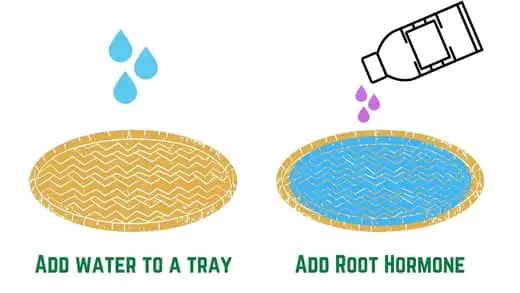
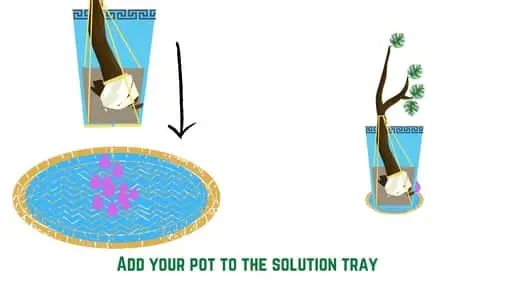
Place your bonsai tree on top – this will have the dual benefit of watering your bonsai but also applying root hormone directly to your tree.
Keep a consistent temperature
One of the best bits of advice I can give for bonsai trees is to maintain a steady temperature in the aftercare of repotting bonsai – it’s one of the reasons I recommend using a propagator.
Bonsai trees are highly susceptible to changes in temperature especially when getting used to new soil.
Most bonsai trees cannot survive conditions warmer than 85 to 90 degrees Fahrenheit and so you must keep the temperature consistent. – hopefully, the table below will help explain this.
| Temperature | Results |
| Below 10 degrees Fahrenheit
(-12 degrees Celsius) | At a temperature less than 10 degrees, bonsai will freeze over, severely impacting its ability to pass nutrients through the tree. If left unchecked this will stunt growth and eventually kill your plant. Ensure you have drainage holes and permeable soil to ensure any excess water can drain easily to avoid mold or fungal infections. |
| 10 to 32 degrees Fahrenheit
(-12 to 0 degrees Celsius) | This temperature range is the lowest temperature range that bonsai can survive at. Frost and ice may start to settle on your bonsai but its overall health will not be severely impacted during the winter months at these temperatures. |
| 32 to 69 degrees Fahrenheit
(0 to 25.5 degrees celsius) | The ideal temperature to keep bonsai at. Not too hot but not too cold either. This temperature will allow for maximum growth and health – especially if kept outdoors. |
| 69 to 89 degrees Fahrenheit
(25.5 to 31.6 degrees Celsius) | The upper limit of temperature for bonsai. Bonsai at this temperature will also have massive growth due to the increased photosynthesis and food available. Just ensure you check for dry soil and water regularly. Underwatering can be a problem. |
| 90 to 99 degrees Fahrenheit
(32 to 37 degrees Celsius) | Bonsai will start to have wilted leaves or drop leaves as a way to conserve energy. Leaves on your tree may also start to rust or turn yellow. At this stage, it is important to try and save the tree by keeping them indoors at a more appropriate temperature. |
| 100 degrees + Fahrenheit
(37.7 + degrees Celsius) | At temperatures of over 100 degrees, bonsai will not be able to survive in this prolonged heat and will prove fatal. Ensure then that you keep in a cooler environment as soon as temperatures start to approach this limit. |
Another factor to look after in the aftercare of your bonsai is that roots won’t propagate properly if the soil temperature is either too warm or too cold.
5 to 30 degrees celsius is typically the best temperature for roots to grow a bonsai tree.
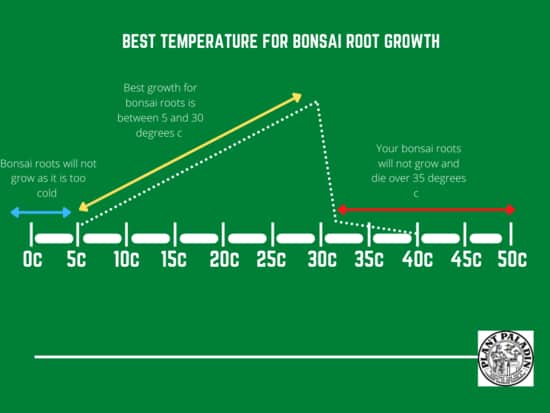
Invest in a greenhouse
Similar to the point above, what better way to manage the shade, temperature, and moisture levels during the aftercare of repotting your bonsai than investing in a bonsai greenhouse.
These will give you direct control of every aspect of your bonsai tree and they don’t have to break the bank.
To read up more on this – check out my post on building a bonsai greenhouse here.
Protect your bonsai from bugs
Sooner or later bugs and all manner of creepy crawlies are going to attack your bonsai trees – especially if you keep your bonsai outdoors.
Slugs, aphids, whiteflies, spider mites, and scale are all common suspects in attacking bonsai trees.
Typically a good insecticide or spraying your bonsai with neem oil or a solution of 30 oz of water mixed with 1 tablespoon of vinegar or washing up liquid works best to remove insects
However, in the aftercare process of repotting a bonsai be careful to only use these techniques in small spades.
This is because your bonsai will be more vulnerable.
A better option if your bonsai does get infected by insects after repotting your bonsai would simply be to use a pressure washer and blast your bonsai tree with water.
This will typically blast off any annoying pests.
For a full overview of how to remove insects from bonsai – check out my blog post here.
Avoid birds
Similar to bugs, in the bonsai repotting aftercare process, bonsai will be more susceptible to attacks by birds – especially if your bonsai bears fruit.
The best thing to do if your bonsai attracts birds is to invest in scarers such as scarecrows – these are surprisingly effective at keeping birds such as blackbirds or ravens away from your tree.
Again I’ve written a full post you can read up more about this here.
Invest in a fungicide
Due to the excess watering used in bonsai repotting aftercare or the weakened state of your tree after the repotting process – there is a much higher chance your bonsai will suffer from a fungal or mold disease.
This is visible with white spots often displaying on the leaves of your bonsai.
If left unchecked these infections can weaken your bonsai tree, causing its leaves to fall off or turn yellow and its branches to shrink.
In repotting bonsai this is especially troublesome as it can lead to your bonsai never successfully managing to repot should it get a fungal disease.
I would recommend investing in a fungicide which can stop a lot of the problems in the bud.
Check your bonsai weekly for signs of white spots and spray your bonsai with a good amount of fungicide.
To read up more on this check out my posts below:
Protect your bonsai from wind
Finally, we come to protect your bonsai from the wind in the aftercare of repotting your bonsai.
Wind can cause your bonsai to dry quicker which can be a problem after repotting your bonsai causing its leaves and roots to dry out before it adapts to the soil – essentially dehydrating your plant
A secondary problem with the wind is that even though you may have secured it, it has not yet rooted comfortably in the pot meaning it can potentially fall over or break the roots before they start to form.
To avoid both of these I would recommend either keeping your bonsai indoors, in a greenhouse, or a propagator for 2 to 4 weeks after repotting your bonsai.
When should I repot my bonsai?
Most bonsai should be remitted every 3 to 5 years. Bonsai trees that are younger than 15 years should be repotted every 2 to 3 years. The species of your bonsai tree will determine how frequently it will be repotted. Faster growing bonsai species will need to be repotted more often.
To help explain this in more detail – I’ve put together a table below with the most common bonsai species and when you should repot them:
| Bonsai species | When to repot? |
| Chinese Elm | 1-2 years |
| Juniper | 3-5 years |
| Jade | 2-3 years |
| Maple | 3-5 years |
| Fukien Tea | 2-3 years |
| Ficus | 2 years |
| Wisteria | 3-5 years |
| Cotoneaster | 1-2 years |
| Pine (most varieties) | 3 to 5 years |
| Azalea | 3 years |
How to successfully repot your bonsai?
To successfully repot your bonsai, repot your bonsai as early into the spring as possible. Dip the roots of your bonsai in rooting hormone and place in a pot that is 80% the size of the widest point on your tree. Water thoroughly and protect from insects and fungal infections.
How long do you have to care for bonsai after repotting?
Bonsai repotting aftercare is typically needed about 4 to 6 weeks after the repotting process. During this period, you must be more vigilant in the care of your bonsai, checking daily for new roots, waterlogging, or insect or fungal infestation.
Why do bonsai trees need aftercare after being repotted?
Bonsai trees that have recently been repotted need aftercare as the roots need time to adapt and grow in the new soil and pot the tree has been moved to. Repotted bonsai are also more vulnerable to disease and insect infestations so extra time is needed to observe this.
What bonsai tree species require more repotting aftercare?
Pine, juniper, and other evergreen bonsai trees are considered the hardest to care for and so require more aftercare when repotting.
What causes a bonsai to die after repotting?
Bonsai trees that die after repotting occur due to roots of the new bonsai not growing in the new soil or pot. Other symptoms include an insect or fungal infection during the reporting process.
Study on bonsai repotting aftercare
So I didn’t just want to leave without consulting a few experts on how they deal with aftercare from repotting bonsai.
First I visited my local botanical gardens and asked them about bonsai repotting aftercare – this is what they said:
” Bonsai trees are a lot weaker when you repot them – the best thing to do is douse them in water and make sure that you protect them from direct sunlight and wind for the first 2-3 weeks”
I also did a poll of 20 plant paladin readers and asked them their best tips for aftercare for repotting bonsai – this is what they said:
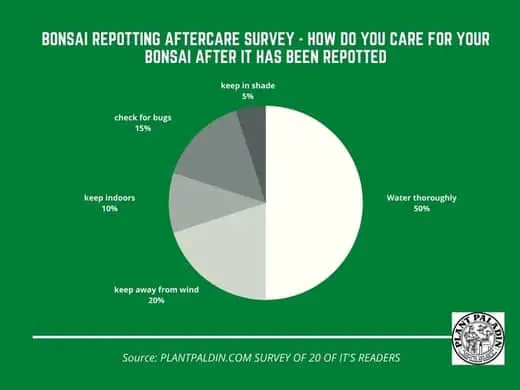
My top picks for the gear you will need!
So like I mentioned earlier, over the past three years of running PlantPaladin, hundreds of people have asked me for my recommendations on the best bonsai gear on the market.
Having spent thousands of dollars on bonsai items these past few years and tested at least 100 bonsai-specific products, I’ve listed my favorite products below – All of which I highly recommend and think you can get great value.
They can purchase directly by clicking the link to take them to Amazon.
Bonsai Tool Set: One of the significant challenges I’ve had is finding a toolset that was not only durable but didn’t break the bank. SOLIGT has recently developed a fantastic bonsai tool set that covers all the tools you need to trim, prune, and repot your trees. – You can grab it here.
Complete Bonsai Set: Many of you will want to grow your bonsai trees entirely from scratch, but finding the varicose seeds, pots, and other items in one place can be challenging. Leaves and Sole then have created a complete bonsai set that I’ve personally used that ticks all the boxes. You can grab it here.
Bonsai wire: The number of times I’ve run out of wire for my bonsai or purchased cheap bonsai wire that doesn’t do the job is embarrassing for me to admit. After a lot of trial and error, I found that using Hotop’s aluminum bonsai wire is one of the best options on the market. This can easily be used for both indoor and outdoor bonsai. You can grab it here.
This post was written by Fehed Nicass who has been passionate about bonsai for over 3 years.
